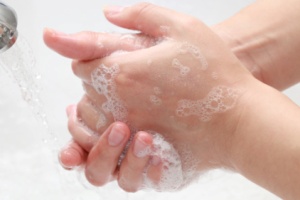 According to the United States Department of Health and Human Services Centers for Disease Control and Prevention (CDC), hand washing or use of alcohol-based hand rubs has been shown to reduce overall infection rates.
According to the United States Department of Health and Human Services Centers for Disease Control and Prevention (CDC), hand washing or use of alcohol-based hand rubs has been shown to reduce overall infection rates.
As an alternative to traditional hand washing with soap and water, the CDC is recommending the use of waterless (alcohol-based) hand rubs by healthcare professionals for hand hygiene.
Wash your hands with plain soap and water; or with antimicrobial soap and water if:
- Your hands are visibly soiled (dirty)
- Hands are visibly contaminated with blood or body fluids
- Before eating
- After using the restroom
- Wash all surfaces thoroughly -- fingers, between fingers, palms, wrists, back of hands
Use a waterless hand-rub for routinely cleaning your hands:
- Before having direct contact with patients
- After having direct contact with a patient’s skin
- After having contact with body fluids, wounds or broken skin
- After touching equipment or furniture near the patient
- After removing gloves
Do not use an waterless hand-rub when hands are visibly soiled or contaminated with blood or body fluids.
It is OK to ask healthcare providers if they have cleaned their hands.
According to the CDC, waterless hand rubs significantly reduce the number of microorganisms on skin, are fast acting and cause less skin irritation.
When using waterless (alcohol-based) rubs, apply product to the palm of one hand and rub hands together, covering all surfaces of hands and fingers, until hands are dry.
Waterless hand rubs are well suited for hygienic hand disinfection for the following reasons:
- Optimal antimicrobial spectrum (active against all bacteria and most clinically important viruses, yeasts, and fungi)
- No wash basin necessary for use and easy availability at bedside
- No microbial contamination of health-care workers' clothing
- Rapidity of action.
- More than 20 published studies prove alcohol-based hand rubs are more effective than soap in reducing the number of bacteria on hands.
- Waterless hand rubs contain skin conditioners (emollients) that help prevent drying effects. Nurses who routinely cleaned their hands between patients by using a modern alcohol-based hand rub had less skin irritation and dryness than nurses who washed their hands with soap and water.
- The use of gloves does not eliminate the need for hand hygiene.
According to the Hand Hygiene Resource Center, nurses, doctors and other healthcare workers can contaminate their hands by doing simple tasks, including:
- Taking a patient’s blood pressure or pulse
- Assisting patients with mobility
- Touching the patient’s gown or bed sheets
- Touching equipment, including bedside rails, over-bed tables, IV pumps
According to the CDC, healthcare professionals should avoid wearing artificial nails and trim natural nails to less than one-quarter inch if they care for patients at high risk of acquiring infections.
Improved adherence to hand hygiene (i.e. hand washing or use of alcohol-based hand rubs) has been shown to terminate outbreaks in health care facilities, to reduce transmission of antimicrobial resistant organisms (e.g. methicillin resistant staphylococcus aureus) and reduce overall infection rates.
The CDC maintains that good hand hygiene is the simplest, most effective measure for preventing nosocomial infections.
Nosocomial infections are infections that a patient acquires while in the hospital. Critically ill patients are most susceptible to becoming infected. The most common infections are caused by staphylococci and multi-drug resistant pathogens such as MRSA, VRE and resistant gram-negative rods. Patients can become ill with bloodstream infections, surgical site infections, urinary tract infections and pneumonia.
Patients often carry resistant bacteria on their skin. Patients with resistant bacteria like methicillin-resistant S. aureus (MRSA) or vancomycin-resistant enterococci (VRE) often carry the organism on many areas of their skin, even when they don’t have any wounds or broken skin.
A scientific study performed in a hospital nursery found that babies acquired staphylococci more frequently when cared for by nurses who didn't wash their hands than babies cared for by nurses who washed their hands between patient contacts with an anti-microbial soap. Other studies have show that washing hands between patient contacts reduces the spread of bacteria in healthcare.
Nearly 22 million school days are lost due to the common cold alone. Some viruses and bacteria can live from 20 minutes to two hours or more on such surfaces as cafeteria tables, doorknobs and desks. A study of Detroit school children showed that washing hands at least 4 times a day can reduce stomach illnesses by more than 50 percent.
Source: www.stmaryhealthcare.org
St, Mary Medical Center
Langhorne, PA
